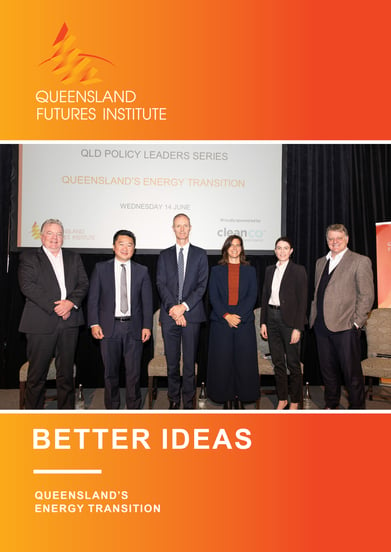
|
Khoa Dao
- Australia Pacific LNG is a joint venture company consisting of shareholders – Origin Energy, ConocoPhillips and Sinopec. The joint venture has invested over $30 billion to develop the coal seam gas business in Queensland, making it the largest producer of coal seam gas in Australia. We supply gas to our liquefaction plant on Curtis Island to produce LNG, which is sold under long-term contracts to our customers in Asia. We also use this fuel to generate electricity, displacing more carbon intensive fuels such as coal and oil.
- The majority of the gas is supplied into the domestic East Coast gas market, covering roughly 25% of the East Coast demand. Additionally, we supply to generators, industrial customers, commercial customers and large retailers who then sell that gas to households.
- There are opportunities for Queensland and Australia in delivering on the vision to become a renewable energy superpower. For Queensland’s energy transition, successfully delivering this vision will support businesses to decarbonise, reducing the emissions our economy and attracting new investments. This will support the growth of our economy and create jobs across Queensland.
- We also face a number of complex challenges in the transition. The first is around attracting the required capital investment. Estimates from the Queensland Government show that we will require $60 billion to reach 80% renewable penetration by 2035. This spans generation, storage and firming capacity. However, with the current economic conditions we are seeing, including the tightness of the labour market, high inflation and interest rates, we are likely to face continued pressure on the price of reaching the vision.
- This highlights the challenge around meeting the path and the pace of the energy transition required. We will require investment in firming capacity, transmission and grid development before we retire existing carbon intensive coal fire power plants, so attracting and planning for this transition is critical.
- Natural gas and APLNG will have an ongoing role to deliver gas resources required throughout the transition, including in servicing industries that are hard to decarbonise through renewable energy.
|

|
Tom Metcalfe
- CleanCo was established in 2018 and is a government-owned energy corporation, owning both generation and retail assets. We inherited assets from Stanwell and CS Energy, including Wivenhoe Dam – the only pumped hydro facility in the state, which is 570MW and Swanbank E – a combined cycle gas facility, that is one of the cleanest in Australia. The portfolio also includes Barron Gorge and Kareeya run-of-river hydro power stations in far north Queensland, which are now considered firming or foundational assets as they are very flexible forms of generation.
- Since being established, CleanCo has signed long-term offtake agreements with some of the largest renewable projects in the state – including Western Downs, a 400MW solar facility, and three wind farms – MacIntyre, Dulacca, and Kaban. Combined, CleanCo owns about 1GW of firming and 1GW of variable energy assets. This allows us to offer firm, renewable energy contracts to large customers like BHP, Wesfarmers and Bunnings.
- Despite the scale of this portfolio, it only serves 3-4% of the retail-connected load in the state. CleanCo must keep growing to continue to be able to offer competitive products and aims to service 20% of the retail-connected load in Queensland by 2030. This will include 5GW of variable energy and 5GW of firming.
- While we need to facilitate new development in Queensland, we are competing with New South Wales and Victoria, as well as the rest of the world. Right now, China has the largest installed capacity of renewable generation worldwide – three times larger than the second largest – the US, which has been recently supported by half a trillion dollars being spent on the renewable transition under the Inflation Reduction Act.
- This highlights the clear need to consider how Queensland can stay competitive, attracting the capital, resources, and equipment needed to support development in the state. Although we have high-quality renewable resources, we need strong policies and frameworks to support the transition, such as in electricity transmission access reform and in environmental and bio-regional planning.
- The Queensland Government has announced $500 million in the budget to support projects, which has been largely funded through the coal and gas royalties. This is a great example of government support which must be continued if we are to further drive the transition in coming years.
|

|
Stephanie Moroz
- EDL is a leading global producer of sustainable distributed energy, headquartered in Brisbane. We own and operate 90 power stations and gas processing facilities across three continents, and own 1GW of generation capacity. We are quite a diverse business and sell 10 different products into 16 different markets. This supports the abatement of 4 million tonnes of CO2 per year, largely by processing waste methane gas. For comparison, Queensland’s net CO2 emissions were 139 million tonnes in 2021. We have been decarbonising for three decades and are well placed to help Queensland on its journey towards net zero.
- There is a significant opportunity to continue supporting Queensland’s decarbonisation. Today, 33% of the state’s emissions are produced from electricity generation. This means that moving from the 22% of renewables in the grid today, to the targets that have been set for 50% in 2030, and 80% in 2035, will make a huge contribution to reducing Queensland’s emissions.
- This will require enormous investment, which EDL understands well. We traditionally owned fossil fuel power stations in remote off-grid communities and mine sites but have been moving towards renewables. In 2017, we supported Coober Pedy in achieving over 70% renewables across the course of the year. Since then, we have been supporting larger sites achieve 80-90% renewables. These systems are being delivered at a lower cost for electricity customers, with higher reliability than fossil fuel generated systems.
- Additionally, stationary industrial energy and transports constitutes 18% and 15% of Queensland’s emissions respectively. Electrification in these areas is another key opportunity. Where these processes are difficult to electrify, there is also real opportunity for renewable fuels, such as biomethane – a renewable source of methane produced when organic matter decomposes and can be captured.
- EDL now owns and operates five biomethane plants in the United States, capturing methane from landfill gas, purifying it, and injecting it into the pipeline as a substitute for natural gas. This is a huge untapped opportunity in Queensland where we could be decarbonising the gas system today.
- The key to overcoming the challenges and taking advantage of the opportunities we face is creating a supportive regulatory environment. This is the reason behind EDL’s biomethane work in the United States. Overcoming global supply chain challenges is also critical – as other global economies are competing with us as they transition to the same technologies, creating bottlenecks in attracting a skilled workforce for example.
- Regulatory and policy reform will also facilitate the required grid development and transmission buildout needed to build the renewables and deliver clean, affordable energy to customers.
|

|
Professor Andrew Garnett
- The Centre for Natural Gas at the University of Queensland is a very broad coalition dealing with matters around the energy transition. We are currently experiencing a tale of two transitions. Firstly, there is the type of transition we are seeing play out in Queensland and across the OECD countries. Then secondly, there is the real transition in the many other areas of the world – including India, China and Africa – which represents the significant area for decarbonisation. Queensland currently consumes about 25% – 1,450PJ of Australia’s energy, 92% of which is fossil fuels – 36% from oil, 35% from coal, 21% from gas – and only 8% from renewables.
- However, the transition is currently largely focused on electricity. If our goal is decarbonisation more broadly, we must think broader than just electricity – and not focus on the number of solar panels or batteries we have.
- There are a number of other considerations that must be made when thinking about energy more broadly. For example, when Ukraine was invaded by Russia we saw an immediate fear for energy supplies – manifesting through increased petrol prices when only 2-5% of global oil supply was under threat. This impacted the lower socioeconomic demographics hardest. On a global scale, rich countries soon outbid the poor countries for gas, and over that period of restricted gas supply we saw an increase in emissions as poorer countries reverted to coal for power generation. Over a hundred million people fell into energy poverty. This meant that 75 million people went from using LPG for cooking to wood, charcoal, and dung. Additionally, 300 million people went into food poverty, as urea and fertiliser shortages occurred and energy inputs to agriculture also increased (and less fertiliser use in 2022 can be expected to have knock on effects on productivity in 2023 onwards).
- The lesson from the above impacts of the Ukraine crisis highlights the need to ensure affordability, reliability and security alongside decarbonisation. Risk management around supply is critical as without this, we may see an increase in energy poverty in Queensland due to another price spike and a loss of ‘social licence to decarbonise’.
|



























